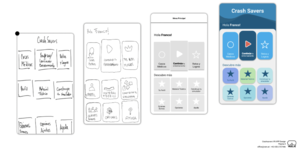
Clinical Case Index[edit | edit source]
CrashSavers VR is an educational gamified smartphone application designed for learners to acquire skills for hemorrhage control techniques. Learners are presented with a series of interactive clinical case scenarios that assess level of knowledge with real-time feedback in the scenarios, in the simulator models, and in a self-assessment module.
The clinical case scenarios and assessment of the learner’s knowledge are structured as follows:
- Case presentation: Learners are presented with a simulated patient and provided data, mechanism of injury, vital signs at the site of the incidence, and brief physical exam targeted on hemorrhage evaluation.
- Data synthesis: Learners must recognize main data points in order to correctly proceed through the clinical case. They must consider a differential diagnosis and an appropriate action plan. This is facilitated by a series of questions in the VR app for the learners to answer.
- Action algorithm: A series of possible action options are presented, with incorrect options framed in red and correct options framed in blue. If learners select an incorrect option, the clinical case scenario will end, and the learner cannot proceed through the case. They will receive immediate feedback explaining why the chosen option is incorrect. If learners select the correct option, they will be able to advance to the next question and proceed until the case is complete.
Clinical case scenarios have been designed for tourniquet placement, manual pressure, and foley placement. The following details refer to the Tourniquet Simulator, but are relevant for the Pressure and Foley Simulators as well.
The VR app contains a module containing instructions and materials for the proper construction of the Tourniquet Simulator that simulates a bleeding extremity. The VR app reviews the fundamentals of tourniquet application, components involved, and steps for correct tourniquet placement. Learners will practice placing a tourniquet on the constructed simulator, followed by completing a self-evaluation survey through the VR app. They will repeat tourniquet placement until all evaluation points listed in the survey have been met and the skills are done correctly so that learners are empowered to transfer these clinical skills in real-life as first responders in life-threatening situations. Appropriate fundamental knowledge and technical skills will be mastered by deliberate practice and repetition so that clinical decision-making and skills transfer naturally to clinical situations.
Overall, learners will create personal accounts, construct the simulator, review educational material, and test knowledge through decision-making exercises and additional gamification techniques. Once learners “pass” all of the clinical case scenarios in the VR app, they will practice applying the tourniquet on the simulator and assess their skills acquisition with a checklist. From the checklist, 90% correct answers is indicative of an “acquired skill” by the learner.
About the App[edit | edit source]

The physical simulator is essential to the psychomotor educational component of the training course, though successful application of appropriate hemorrhage control techniques still requires a thorough understanding of indications and patient presentations in different clinical circumstances. Accordingly, our VR app has been designed in the setting of a gamified learning environment to enhance engagement and retention and to complement the physical model. The CrashSavers VR app includes the following components:
- Step-by-step instructions on constructing the DIY Simulator
- Educational material on anatomy and decision-making for different hemorrhage control techniques
- Virtual simulator to master skills and steps for hemorrhage control techniques
- Self-assessment
The educational material includes content on anatomy, decision-making, and video instruction on how to appropriately perform the hemorrhage control techniques for both the simulator and real-life scenarios. The virtual simulator component within the VR app will allow learners to practice the steps of the different hemorrhage control techniques in order to become competent. Upon completion of the educational modules, learners will advance to performing their learned skills on the physical simulator model.